
Page 16: of Marine Technology Magazine (January 2013)
Subsea Vehicle Report: Unmanned Underwater System
Read this page in Pdf, Flash or Html5 edition of January 2013 Marine Technology Magazine
searchers today worry that if Þ sh consume these spherules, which com- monly resemble Þ sh eggs, that PCBs and other persistant organic pollut- ants (POPs) will bioaccumulate and magnify up the food chain, eventually impacting humans. Researchers from SEA implemented the neuston net into their research program in the mid 1980s. Since then they have collected more than 100,000 pieces of plastic and currently possess the largest data set on plas- tic pollution in the Atlantic Ocean. In 2001, they began the task of quanti- fying plastic pollution in the PaciÞ c Ocean. But one issue that has consistently plagued the neuston net was in its de- sign. Scientists have observed that in ÒswellyÓ conditions, the neuston net tends to bounce from wave to wave. To get accurate measurements of what exists on the surface of the ocean, scientists must know how long the net was in the water. For example, if the net was deployed for half an hour and was being dragged at a speed of 2 knots, researchers can assume that the net was in the water for one nautical mile. However if the net bounces out of the water between waves, research- ers have no idea how much area the net covered. In 1981 a new surface sampling net entered the oceanographic scene. The manta net attempted to Þ x some of the design errors of the neuston net by attaching a large wing to the top of it, making the net look similar to that of the manta ray. Along with the wing, the net also includes a counter- balancing weight, sinking the net and preventing it from bouncing from swell to swell.ÒThe manta net has been the standard for many years,Ó said Kara Lav- ender Law, research professor with SEA. ÒSEA has continued to use the neuston net for a couple of reasons, namely for consistency with our his- torical archive, and the ease with which it can be deployed, recovered and processed.Ó ÒBoth nets tow at the surface of the ocean,Ó said DeForce. ÒThe neuston net is easier to deploy because it does not require a hydrowinch and it takes up less space on the ship.Ó Researchers with the Algalita Foundation and 5gyres, organizations also focused on the issue of plastic pollution, have begun modifying the manta net so that it can be used on a variety of vessels, even vessels not typically associated with oceanographic research. By changing the size of the manta net and adding detachable wings, they have recently created the ÒSuitcase Manta TrawlÓ. Another variant, the ÒHi-Speed TrawlÓ, has a considerably smaller net opening that allows a vessel to tow the net at higher speeds. Below the Surface ÒOn a cruise in 2009 in the North PaciÞ c,Ó said Giora Proskurowski, a Principal Investigator with SEA, Òthere was this period where the wind died down. I noticed on the surface of the ocean way more white ß ecks. It was calm and the lack of turbulence allowed each piece of plastic to rise to the surface.Ó In windy weather, scientists have discovered that plastic tends to get mixed into the water column. This means that the amount of plastic that has been sampled is signiÞ cantly lower than what actually exists. ÒI went back through every tow we had data on and looked at the aver- age wind speed during a tow and compared it to the number of pieces of plastic for every tow in the PaciÞ c and Atlantic subtropical gyres and it was a pretty obvious connection that at high wind speed you had low plastic,Ó said Proskurowski. To sample plastics at depth, scientists with SEA used a Tucker trawl dur- First Person Contrary to popular opinion, the ?Patch? is not a continu-ous eld of debris, is not vis- ible from space, nor is it an ?island of trash.?The neuston net sampling the surface of the ocean for plastic. Retrieved plastic pieces stuck on the neuston net. Almost 95% of the plastic found in the North Paci Þ c Subtropical Gyre is millimeter sized.January/February 2013 16 MTRMTR #1 (1-17).indd 16MTR #1 (1-17).indd 161/28/2013 11:08:51 AM1/28/2013 11:08:51 AM

 15
15

 17
17
